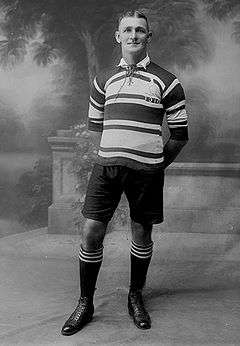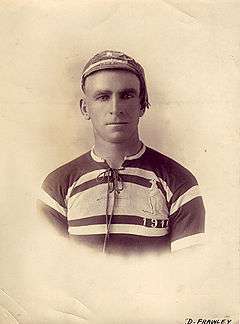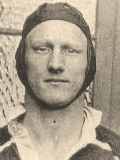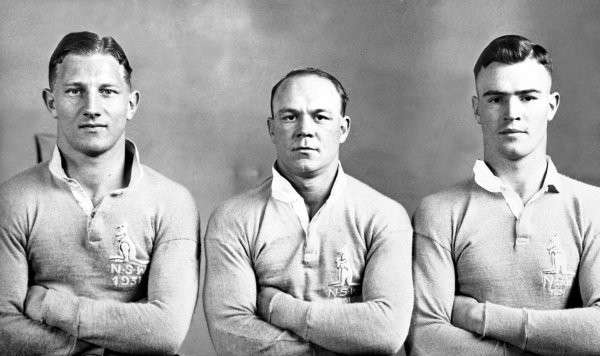History of the Sydney Roosters
The history of the Sydney Roosters stretches back from the birth of rugby league football in Australia in 1908 to the present day. It is the only remaining club to have played every season of top-tier football in Australia's history.
Foundation years
There have been several rugby teams known as Sydney F.C., dating back to the first ever rugby club in Australia in 1860. On 24 January 1908 Eastern Suburbs decided at a meeting held at Paddington Town Hall to leave behind its Union counterparts and enter into the NSWRL. Bringing with them their local playing strip as worn during the rugby union days consisting of red, blue, and white, the Eastern Suburbs District Rugby League Football Club was born. The Eastern Suburbs District Rugby League Football Club, as it is still officially known today, was formed according to its articles of association with the NSWRL, to propagate the game of Rugby League in the eastern municipalities in the Sydney metropolitan areas, including the City of Sydney, Paddington, Darlinghurst, Vaucluse, Woollahra, Waverley and Randwick local government areas.


With the NSWRL being able to sign Union crowd favourite Dally Messenger, Easts were handed his services due to rule stipulations regarding players playing for their local area. Easts were led out for the first time by captain Henry "Jersey" Flegg and started off their existence with a 32–16 victory over Newtown in front of a crowd of 3000 at Wentworth Park. The "Tricolours" would remain competitive throughout the entire season even without star player Dally Messenger at the beginning of the season due to representative commitments.
The Tricolours fielded a star-studded lineup including Dan Frawley, Lou Jones, Sandy Pearce, Larry O’Malley, Albert Rosenfeld, Dally Messenger, and captain Jersey Flegg and lost only one regular season match that year. Although without several star players due to the 1908 Kangaroo Tour, Easts were able to defeat North Sydney to earn the right to face Souths in the final. In a highly contested match, Easts were close to snatching victory in the final minutes with a try in the corner. Trailing 14–12, the Tricolours were unable to make the conversion to force a re-match, and the inaugural premiership went to the Rabbitohs.
In 1909 Easts showed early signs of improving on the previous years' efforts. However a five-game losing streak towards the back end of the competition saw the Tricolours bow out of contention. There was little improvement in 1910 - the team failed to show any form of consistency and eventually missed out on a semi-final berth.
In 1911 Easts finally reaped the full benefits of Dally "The Master" Messenger, who declined to tour with the Australian team. Defeating Souths for the right to challenge minor premiers Glebe for the premiership, the Tricolours took Glebe on with the knowledge that a victory would entitle them to a re-match for the premiership. Winning 22–9 in the first of the two games, Easts were able to prevail 11–8 after a come-from-behind victory to take out their maiden premiership. Messenger was instrumental in the win, scoring a try, converting two others and kicking a field goal to help the Tricolours in their performance.
In 1912 a rule-change was implemented, with the minor premier automatically declared premiers. Backing up with their previous year’s performance, both the Tricolours and Glebe remained the two stand-out teams throughout 1912. With both teams suffering only one loss during the lead up to their match, it was anticipated that although four matches would remain after their clash, the winner would more than likely take out the premiership. In front of an approximate crowd of 25,000 at the Sports Ground, Dally Messenger once again proved the difference kicking a field goal minutes before full-time to lead the Tricolours to victory 6–4 in a close rain-soaked and muddy game.
In 1913 Easts again proved dominant, losing only to Newtown and Glebe. Easts finished atop of the ladder and were handed the 1913 Premiership. Completing their first premiership treble, Easts would also become the first team to ever win three premierships in a row. The 1914 season showed signs of promise from the Bondi-based team who, during the middle of the season, looked quite capable of taking out their fourth premiership in as many years. However key losses in their final five games saw the Tricolours finish 3rd for the end of the year. The following years showed little sign of improvements with Easts failing to finish higher than 5th.
The war years
With the introduction of the "first-past-the-post" era, where teams finishing on top of the ladder remained unchallenged, Easts had to settle for runners-up in both 1919 (Balmain) and 1921 (North Sydney). At the end of the 1923 season, both Easts and Souths finished equal first, resulting in a Grand Final between the two inner-Sydney clubs. The result was a spectacular 15-12 win by Easts in which captain Harry Caples proved the difference by scoring a late try to seal victory. The win gave the Bondi-based team their 4th premiership.
The 1930s would provide one of, if not the most successful era of the Eastern Suburbs club in its long and rich history. Finishing joint minor premiers to the more experienced Wests team in 1934, Easts came short of winning the premiership by going down to Wests 15-12.
With the presence of the legendary Dave Brown, who at this stage was setting point scoring records (that still remain unbroken to the present day), Eastern Suburbs were always going to finish on top of the premiership table. Finishing a massive eight points ahead from their next opponent, Easts progressed into the Grand Final by defeating Wests in the major semi-final 15-10. The only team capable of stopping the mighty Easts failed to do so in the Grand Final, with Souths going down to the eventual premiers 19-3 in front of 22,106 spectators.

Easts would retain the premiership in 1936, defeating Balmain 32-12 to claim their 6th premiership. Celebrating their 30th year of existence in 1937, Easts completed their second premiership treble by finishing minor premiers in a shortened season due to a Kangaroo Tour, which saw them automatically handed the premiership.
Feeling the strain of representative commitments having supplied eight players for the Kangaroo Tour, it would only be towards the back end of the 1938 season that Easts would show shades of their previous winning formula. In a not-so-easy task, Easts defeated Souths in the minor semi-final to take on the unlikely opponent of Canterbury, who three years before were torn apart by the Roosters in an 87-7 flogging. However the turn-around was evident when Canterbury took out the premiership with a 19-6 win over the tricolours.
It would only take two years for Easts to exact revenge on the Canterbury-based team. Meeting them in the 1940 Grand Final after taking out the Minor Premiership, Easts prevailed 24-14 to claim their fourth premiership in six years. The following year Easts once again were able to make the Grand Final, however a determined St. George outfit removed all hopes of further premiership glory for the tricolours with an impressive 31-14 win. Taking out their seventh Minor Premiership in 13 years, Easts headed up the 1945 Grand Final against fourth placed Balmain. With an inspirational three tries and five goals by Dick Dunn, Easts took out the premiership 22-18 and moved up to second on the list of most premierships, only three behind Souths.
Birth of the Rooster
For much of the first half of the 20th century, the Eastern Suburbs club was known colloquially as the "Tricolours" after the club colours of red, white and blue. Occasionally, the club was also referred to as the "Beachsiders" or the "Seasiders". In the 1960s, adopting a new playing strip that consisted of a V-shaped design similar to that of the popular French teams who also wore red, white, and blue, the Eastern Suburbs club became known as the Roosters. This was due to the similarities of the French team jersey, which displayed a cock badge on their jersey.
However it is contested by fans of the day that the rooster was associated with the football club decades earlier. This claim is strengthened by newspapers in the 1930s depicting photos of a rooster-top weather vane pointing eastward when publishing articles on the Sydney Roosters. The explanation given being that Eastern Suburbs being in the east, is where the sun would rise hence where the rooster would crow first. The football club itself has neither confirmed or denied both origins of the rooster mascot although the first mentioned origin is generally the wider accepted one amongst the rugby league community.
The Roosters were able to make the 1960 Grand Final, but their opponents were St. George who were in the middle of a dynasty that lasted eleven premierships. The Jack Gibson-captained side was to be no match for the Dragons, with Easts defeated comprehensively 31-6. The 1960 Grand Final would remain the highlight of the decade for the Roosters, who would experience their worst era yet. Consistently finishing at the bottom of the table, the Roosters would make history in 1966 by failing to win a single a game. 1967 however brought redemption for the Roosters, who were able to shake off the ghosts of the previous seasons by finishing in fourth place under the guidance of rookie coach Jack Gibson.
The glory years

The 1970s would become a very successful decade for the Roosters, competing in four Grand Finals, two in which they went on to become premiers, and fielding a team that will be remembered as one of the greatest ever. Reaching the Grand Final against Manly in 1972, Easts led early on before a series of mistakes and lost opportunities saw valiant comeback by Manly who went on to win 19-14.
With the introduction of Easts Leagues Club which would become their backbone of success for years to come, the Roosters were able to bring back Jack Gibson to the Bondi-based club and along with a team including the likes of Mark Harris, John Brass, Bill Mullins, Russell Fairfax, Johnny Mayes, John Peard, Ron Coote, Ian Schubert and captain Arthur Beetson. A recipe for success was slowly building.
In 1974 and 1975 the Roosters would dominate the competition like no team had before them. Losing only five regular season matches over both years, the Roosters were able to steamroll their way to the 1975 Premiership on the back of a premiership record of 19 wins in a row which was only eventually stopped in the first semi-final with the loss coming at the hands of St. George. The Roosters were able to exact revenge though, with both teams meeting up weeks later in the Grand Final; a match remembered famously for Graeme "Changa" Langlands' white boots. The Roosters destroyed the Dragons with a 38 points to nil win.
While the 1976 season may not have brought premiership success it did see the introduction of jersey sponsorship in the game, the Roosters once again leading the field, negotiated a $50 000 a season deal with the City Ford company. The move met with some opposition at first but the other clubs quickly followed and today jersey sponsorship is common place in the game.
Remaining competitive throughout the remainder of the decade, the Roosters returned to the Grand Final scene in 1980. Taking on the Canterbury-Bankstown Bulldogs team known as the "Entertainers", the Roosters were easily disposed of, being defeated 18-4 in the decider. In 1981 the Roosters were thought to get a chance of redemption after winning the minor premiership, however, crucial losses at the back end of the season saw them watching the Grand Final from the grandstands. 1982 would see the Roosters field one of their most competitive teams for a long period of time. Making the preliminary final against defending premiers Parramatta, the Roosters were sent packing with a 33–0 defeat. It would be a long wait for Roosters fans before they would once again see a genuine premiership contending team.
The "Transit Lounge" era
Considered one of the darkest eras for the Roosters since the 1950s and 1960s, the Roosters would show little signs of success throughout this time. The period has recently been bestowed the nickname the "Transit Lounge" amongst fans due to the club's persistence to purchase established players often past their peak at an incredible price. Lasting more than a decade from 1983 to 1994, the Roosters were only capable of making the finals once during 1987 in which they were defeated by the Canberra Raiders in the preliminary final. This period drew little highlights from the club which saw only three Australian representatives being produced in Trevor Gillmeister, Craig Salvatori, and David Trewhella. Easts also reached the final of the 1984 National Panasonic Cup but lost to the Brisbane 1sts.
Super League and beyond

A bitter Super League war saw the arrival of coach Phil Gould in 1995. A year later, Australian captain Brad Fittler would follow in a show of no faith in the Super League-bound Penrith Panthers. Reaching the semi-finals for the first time in nine years, the Roosters bowed out of the 1996 competition with losses to the eventual Grand Finalists in Manly and St. George.
The 1997 line-up seemed one of the best on paper in the Australian Rugby League competition, consisting of players such as Terry Hermansson, Jason Lowrie, Adrian Lam, Luke Ricketson, David Barnhill, Scott Gourley, Matt Sing, Andrew Walker and Ivan Cleary. With all accompanying Brad Fittler, the newly named Sydney City Roosters took their premiership campaign to the Grand Final qualifier. Equalling the scores at 16 a piece with two late tries, the Roosters' Grand Final hopes ended with a field goal by Manly in the final minutes.
In a newly formed and unified National Rugby League competition, the Roosters were able to finish 6th to secure a finals berth. Away wins against the Melbourne Storm and Newcastle Knights saw the Roosters progress to the Grand Final qualifier for the second year in a row, where they were defeated comfortably by the fancied Brisbane Broncos on their ground.

1999 saw few highlights from the Roosters, which bowed out of contention with two straight final losses. The efforts of captain Brad Fittler, who displayed one of his most dominant performances for the Roosters with two solo tries, was not enough to defeat the newly formed St George Illawarra Dragons. With a change of coach in Graham Murray and an entirely new playing style in 2000, the Roosters progressed through to the Grand Final on the back of a tight victory against Newcastle in the Grand Final qualifier, where the Brisbane Broncos prevailed 14–6 in a dominant performance.
The Roosters would only have to wait two years to return to the Grand Final stage. Now under the direction of coach Ricky Stuart, the Roosters capitalised on a 9-game winning streak leading into the Grand Final to surprise the critics and take out the 2002 premiership with a 30-8 performance against minor premiers, the New Zealand Warriors. Trailing by two points early in the second half, the Roosters capitalised on Brad Fittler 40/20 kick to allow Craig Wing to score, setting up a Roosters victory. The win put the Roosters ahead of the Balmain Tigers on the all-time winners list with 12 premierships, still 8 premierships behind South Sydney.
The chance to gain premiership number thirteen came unstuck in 2003. Backing up with another appearance in the Grand Final, the Roosters were tormented by dropped balls at crucial times in a game taunted by wet weather. The Roosters did however have the chance to take the lead midway through the second half when winger Todd Byrne made a clear break, but he was dragged into touch by Scott Sattler. The Penrith Panthers took their second premiership ever, defeating the Sydney Roosters 18-6 in what many describe as the biggest upset since Balmain defeated Souths in 1969. The Roosters once again reached the Grand Final in 2004 against arch rivals the Canterbury Bulldogs. Canterbury won the game 16–13 in Roosters captain Brad Fittler’s last match.
Having lost their star playmaker in Fittler, the Roosters struggled to mount any sort of attacking capabilities in 2005, although they were still able to show promising signs in the team's defence. This was not enough to secure the Roosters a finals berth, who missed out for the first time since 1995.
Batting for the century
With promising signings in both Braith Anasta and Ashley Harrison and alongside talented youngsters such as Iosia Soliola, the Sydney Roosters looked to have a promising 2006 season ahead of them. However playing in their 99th season, the Roosters could be compared to a nervous cricketer with 99 runs waiting to break the century mark.
Winning only eight games for the entire season for one of the worst performances in the clubs history, the Roosters showed capable signs of winning most games. However, poor game plans and a lack of team composure saw the tricolours outdone by most of the opposition.

Coach Ricky Stuart would pay the ultimate price for such a poor performance, being sacked of the coaching role having only been told months earlier that the club would see out his contract that lasted until the end of 2007.
Marching on to their 100th season in 2007 with 999 wins under their belt, the Roosters signed two-time premiership winning coach Chris Anderson to head coach for the 2007 and 2008 seasons with the notion of blooding newly promoted assistant coach Brad Fittler to top position in season 2009.
The centenary season celebrations were delayed after the Roosters lost their opening five games, including the 'Monday Night Football' blockbuster between arch-rivals South Sydney Rabbitohs in round 1. The 1000th win finally came in the annual ANZAC Day clash against St George Illawarra Dragons downing the Dragons 18-4. Victories were few and far between and the lowlight of the season came in round 17 when the Manly-Warringah Sea Eagles defeated the Roosters 56-0.
The defeat would end Chris Anderson's coaching career thus far, deciding to step down from the head coaching role and allowing Brad Fittler to step into the top job. Fittler's late season charge showed promising signs of hope in 2008, although the Roosters would miss out on the finals, Fittler managed to lose only 2 matches for the remainder of the season and recorded significant victories against eventual grand final winners the Melbourne Storm and arch-rivals the South Sydney Rabbitohs in the final round.
Also in 2007 the Sydney Roosters High Performance Centre and Administrative departments set up their headquarters at the Sydney Football Stadium.[1]
The Roosters built on their late 2007 promise in the 2008 season, finishing in the top 4 of the minor premiership. However they ended the regular season with a series of losses which effectively derailed their momentum going into the playoffs. They were eventually knocked out in the second round of the finals series by the New Zealand Warriors.
Despite this, hopes were high at Bondi going into the 2009 season, however so far it has proved to be a disaster, with the Roosters currently dead last on the NRL table with the worst defensive record in the league. Their long term sponsor, Samsung, has dumped them because of poor player behaviour and their season. The Roosters are considering changing their name to the Bondi Roosters, but it has not been confirmed yet.
After a horrible season in 2009, Roosters started to rebuild their team with the signing of Brian Smith from Newcastle Knights as their coach to replace sacked Brad Fittler for 2010 season. They also signed a new major sponsor, Steggles. Roosters then signed Todd Carney, Daniel Conn, Aidan Guerra, JP Du Pulessis and other players to rebuild their season in 2010. Overall, after 26 rounds of 2010 season, Roosters have finished sixth which secured them finals berth. In their first Finals match of 2010 the Sydney Roosters pulled off a miraculous come-from-behind victory over the Wests Tigers in what has been dubbed 'The Greatest Rugby League Game In History.' They then went on to record comprehensive victories over the Penrith Panthers and Gold Coast Titans. The Sydney Roosters qualified for their first grand final since 2004. The Roosters lost the grand final 32–8 to the St George Illawarra Dragons.
The 2011 and 2012 seasons for the Roosters were below average, missing out on the top 8 during both seasons. Brian Smith was soon sacked as coach of the Roosters after the disappointing seasons, and was soon replaced by Trent Robinson for the 2013 season. Club captain Braith Anasta, who departed to from the Roosters to Tigers, was replaced by Golden Boot-winning fullback Anthony Minichiello who had played for the Roosters since 2000. With a new roster of players, this proved an excellent season for the Roosters who took out the minor premiership before winning the grand final 26–18 against the Manly Warringah Sea Eagles. The 2014 and 2015 Sydney Roosters campaigns were also successful, each year winning the minor premiership but losing in the preliminary final.
Team song
The current song is labelled "Rooster Man", a revamp of the original tune Macho Man performed by the Village People.[2] However the traditional club song, "Here come the Roosters",[3] favoured by many of the traditional fans, goes as follows:
- Easts know how to play the game, they play it hard and fair,
- Easts know how to win the game, they win more than their share.
- They're great to see in action, these boys who show the way,
- Put the Roosters on the field, they'll show you how to play.
- Here come the Roosters, the best we've ever seen,
- The red, white and bluesters, the Eastern Suburbs team.
- "Easts to win" shout the cry that everybody knows,
- If you play this football game beware the Roosters crow.
- They're great to see in action, these boys who show the way,
- Put the roosters on the field, they'll show you how to play.
- Here come the Roosters, the best we've ever seen,
- The red, white and bluesters, the Eastern Suburbs team.
References
- ↑ "SCG Trust Timeline". sydneycricketground.com.au. Sydney Cricket & Sports Ground Trust. Retrieved 2009-09-02.
- ↑ Rooster Man Sydney Roosters minisite. Retrieved on 10 July 2006.
- ↑ Here come the Roosters Sydney Roosters minisite. Retrieved on 10 July 2006.
